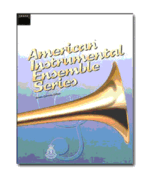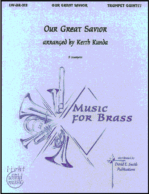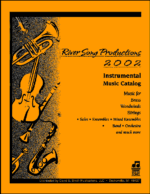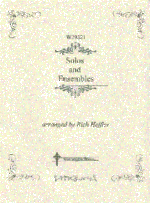-
Fanfare Overture on St. Anne
$29.95The hymn tune “St. Anne” was composed in 1708 by William Croft, the organist at St. Anne’s Church, Soho, London. The words, “O God Our Help in Ages Past” were written by Isaac Watts, also in 1708, as a paraphrase of Psalm 90. For a hymn, the tune is remarkably strong and resolute and has often been used by other composers, notably J. S. Bach and Handel, as the basis for different compositions.
This particular “fanfare overture” setting of the tune is somewhat in keeping with the contrapuntal uses that were in fashion when the tune was originally composed. Instead of standard percussion, for example, timpani alone are used, a reference in style to the celebratory percussion and trumpet combinations of the 18th century.
-
O God Our Help
$16.00A brass choir scored for 3 trumpets, 4 horns, 3 trombones and tuba. Beginning in a regal fashion, the opening statement of the theme is solemn, then punctuated with upper brass fanfare figures followed by contrapuntal interest and increased textures.
-
-
O God Our Help In Ages Past
$14.95(2 tp, 1 trb/asx, 2 trb/tsx/bart.TC prts for hn & tba; playable as br 4/5/6)
-
O God, Our Help….Passacaglia /Fugue
$5.50Written in typical passacaglia (theme in the bass line) and Fugue fashion, the theme is presented in the piano. The first variation is a gently modified tune in duple with the accompaniment in triplets. In variation two, the tune is rhythmically altered while the upper accompaniment is presented in a spritely fashion. Variation three, the tune is in a triplet moving nature while the theme is in block harmonization in the accompaniment. Variation four is expressive in an almost cadenza fashion. Finally, the Fugue is in a lively four voice manner, ending with a strong proclamation of the title, itself.
-
O God, Our Help….Passacaglia /Fugue
$5.50Written in typical passacaglia (theme in the bass line) and Fugue fashion, the theme is presented in the piano. The first variation is a gently modified tune in duple with the accompaniment in triplets. In variation two, the tune is rhythmically altered while the upper accompaniment is presented in a spritely fashion. Variation three, the tune is in a triplet moving nature while the theme is in block harmonization in the accompaniment. Variation four is expressive in an almost cadenza fashion. Finally, the Fugue is in a lively four voice manner, ending with a strong proclamation of the title, itself.
-
O God, Our Help….Passacaglia /Fugue
$5.50Written in typical passacaglia (theme in the bass line) and Fugue fashion, the theme is presented in the piano. The first variation is a gently modified tune in duple with the accompaniment in triplets. In variation two, the tune is rhythmically altered while the upper accompaniment is presented in a spritely fashion. Variation three, the tune is in a triplet moving nature while the theme is in block harmonization in the accompaniment. Variation four is expressive in an almost cadenza fashion. Finally, the Fugue is in a lively four voice manner, ending with a strong proclamation of the title, itself.
-
O God, Our Help….Passacaglia /Fugue
$5.50Written in typical passacaglia (theme in the bass line) and Fugue fashion, the theme is presented in the piano. The first variation is a gently modified tune in duple with the accompaniment in triplets. In variation two, the tune is rhythmically altered while the upper accompaniment is presented in a spritely fashion. Variation three, the tune is in a triplet moving nature while the theme is in block harmonization in the accompaniment. Variation four is expressive in an almost cadenza fashion. Finally, the Fugue is in a lively four voice manner, ending with a strong proclamation of the title, itself.
-
O God, Our Help….Passacaglia /Fugue
$5.50Written in typical passacaglia (theme in the bass line) and Fugue fashion, the theme is presented in the piano. The first variation is a gently modified tune in duple with the accompaniment in triplets. In variation two, the tune is rhythmically altered while the upper accompaniment is presented in a spritely fashion. Variation three, the tune is in a triplet moving nature while the theme is in block harmonization in the accompaniment. Variation four is expressive in an almost cadenza fashion. Finally, the Fugue is in a lively four voice manner, ending with a strong proclamation of the title, itself.
-
O God, Our Help….Passacaglia /Fugue
$5.50Written in typical passacaglia (theme in the bass line) and Fugue fashion, the theme is presented in the piano. The first variation is a gently modified tune in duple with the accompaniment in triplets. In variation two, the tune is rhythmically altered while the upper accompaniment is presented in a spritely fashion. Variation three, the tune is in a triplet moving nature while the theme is in block harmonization in the accompaniment. Variation four is expressive in an almost cadenza fashion. Finally, the Fugue is in a lively four voice manner, ending with a strong proclamation of the title, itself.
-
O God, Our Help….Passacaglia /Fugue
$5.50Written in typical passacaglia (theme in the bass line) and Fugue fashion, the theme is presented in the piano. The first variation is a gently modified tune in duple with the accompaniment in triplets. In variation two, the tune is rhythmically altered while the upper accompaniment is presented in a spritely fashion. Variation three, the tune is in a triplet moving nature while the theme is in block harmonization in the accompaniment. Variation four is expressive in an almost cadenza fashion. Finally, the Fugue is in a lively four voice manner, ending with a strong proclamation of the title, itself.





